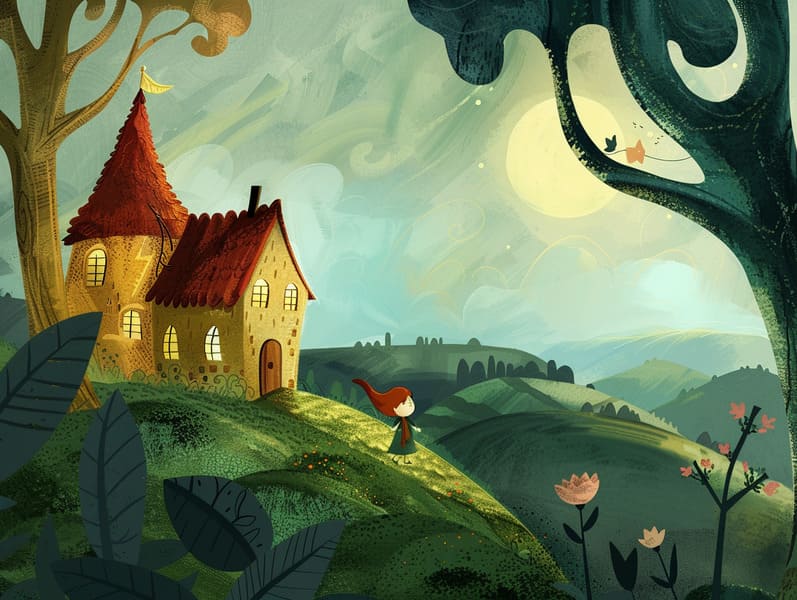The Birth of Ancient Fairy Tales and Its Steadfast Grandeur.

Popular fairy tales have legendary status. These narratives have been conveyed from one generation to the next millennia before they were ever recorded. They emerged from a variety of civilizations, including Eastern traditions. They were initially told among grown-ups, often carrying themes and messages aligned with the societal norms and beliefs of the time.
The Grimm brothers, Jacob and Wilhelm (the Grimm brothers), were among the first to collect and release many of these beloved tales. Their volume, "Grimm's Story Collection," included classics like "The Little Glass Slipper," "Little Brother and Little Sister," and "Snow White," which have since become mainstays in the world of classic fairy tales. Similarly, Hans Andersen's enchanting stories, such as "The Sea Maid," and "The Ugly Duckling," have gained the love worldwide, solidifying their place in the pantheon of treasured fairy tales.
Despite their ancient origins, these tales remain as pertinent as ever, especially as nighttime stories for kids. These whimsical stories are now available in different formats, including gorgeously illustrated books, charming animations, and digital fairy tales.
Their enduring popularity can be connected to several magical reasons:
Important Morals: Timeless fairy tales often whisper important moral lessons. Stories like "The Wolf and the Liar" teach the virtue of being truthful, while "The Race of the Tortoise and the Hare" stress the merits of perseverance and humbleness. These stories offer little ones clear distinctions between truth and falsehood, forming their moral compass in a kind yet lasting way.
Empathy and Awareness: Classic fairy tales frequently depict heroines facing tests and troubles, fostering young readers to relate with their struggles and rally behind their triumphs. For instance, "The Story of Beauty and the Beast" emphasizes the benefit of looking deeper to recognize the true essence of a soul, enhancing compassion and perception.
Cultural Comprehension: Many ancient fairy tales are rich in the cultural contexts from which they arose. Understanding these fairy tales can provide delightful insights into different cultures, promoting a sense of global insight and acknowledgment.
Inventiveness and Fantasy: The supernatural elements in fairy tales—wizardry and magic—motivate children’s creative minds. These tales bring readers to enchanted realms, engendering creative thinking and a sense of amazement that stays a lifetime.
Ancient fairy tales are not only fantastical but also edifying. They serve as alluring tools in building various intellectual and emotional capacities in young ones. When classic fairy tales are spoken out loud, they boost language development by offering new phrases and sophisticated sentence structures. This practice also advances listening abilities and attention span, as young ones focus on every detail, keen to see what happens next.
Furthermore, contemplating the themes and characters of classic fairy tales can foster cognitive skills and logical thinking. The young are educated to notice patterns, guess what will happen, and grasp cause and effect. These analyses also ease children reveal their thoughts and feelings, nurturing their emotional intelligence.
In today’s information age, the abundance of web-based fairy tales has made these fairy tales more attainable than ever. Internet resources and software provide ample collections of popular fairy tales that can be enjoyed or listened to anytime, anywhere. Fairy tales read aloud are particularly sought after, featuring an engaging way for the young to enjoy these enchanting tales. Read-aloud stories and read-to-me videos guide characters and settings to life, often supplemented by fantastical music and harmonies that improve the storytelling journey.
The unending appeal of ancient fairy tales lies in their ability to alter to new eras while keeping their central values. Contemporary modernizations of these narratives often showcase more diverse protagonists and modern settings, making them relevant to today’s audience. However, the underlying themes of valor, warmth, and justice remain unchanged, continuing to connect with listeners of all ages.
Classic fairy tales also offer a sense of contentment and homeliness. They afford a ordered narrative with a evident beginning, these guys middle, and end, often finishing with the solving of conflicts and the triumph of virtue over vice. This dependability can be calming for kids, distributing a sense of consistency in an fluctuating world.
Ancient fairy tales continue to enchant and enlighten new generations, maintaining their loveliness and importance in modern society. As kids' bedtime tales, they disclose a perfect blend of allure and teaching, backing moral values, empathy, and creativity. The existence of internet fairy tales and the likability of fairy tales read out loud warrant that these old stories remain available to new generations.
By defending and imparting these tales, we continue to esteem the rich tapestry of cultural legacy and cultural heritage. Whether you are accessing a gorgeously illustrated book, discovering a electronic library, or listening through an spoken story, the grandeur of popular fairy tales is always within reach. These stories remind us of the undying effect of fairy tales and its ability to draw us together across epochs and places.
Even if you are exploring a richly illustrated book, delving into a digital collection, or playing an spoken story, the grace of famous fairy tales is always within reach.
These stories reveal of the unending effect of fairy tales and its ability to link us across eras and regions, forging a link that fascinates and enlightens alike.